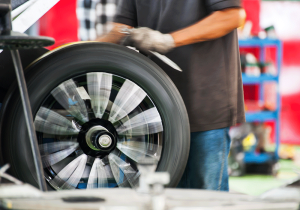In addition to maintaining proper inflation pressure, regularly inspect the tire tread and sidewalls for irregular tread wear, cracking, scrapes, bulges, cuts, snags, foreign objects, or other damage resulting from use. Remove any stones, glass, and foreign objects embedded in the tread to prevent further damage. Even minor damage can lead to further injury and eventual tire failure. Tires with excessive cracking on the tread or sidewall should be removed. This is typically caused by under inflation, over loading, improper storage, or improper long-term parking. Consumers should check tread and sidewall areas during monthly inflation pressure checks, looking for uneven or irregular tread wear or other conditions as noted above. It is recommended that we inspect the tires, including the spare, so we can thoroughly check for any issues.
Uneven Tread Wear on the Tires
This can include more wear on one tread edge than the other, a rippled pattern of high and low wear, or exposed steel wire. Uneven wear can be caused by problems such as under inflation, vehicle misalignment, and improper balancing.
Tread that is Shallow
Well-worn or bald tires can result in hydroplaning, loss of traction and are more likely to be damaged by potholes and other road hazards. Replace tires when there is worn tread depth anywhere on the tire. To help you see when the tread is worn out, tires have a built in tread wear indicators. These are narrow bars of smooth rubber that run across the tread. When the tread is even with the bars, a tire is worn down and the tire must be replaced immediately. You can also try the penny test: place a penny in the tire’s most worn groove with Lincoln’s head facing down. If you can see the top of Lincoln’s head, the tire should be replaced.
Other Items to Check for
When you inspect the tires, make sure to look for small stones, pieces of glass, bits of metal, and other foreign objects that might be wedged into the tread and carefully remove them. They can cause serious problems if they are pushed farther into your tire as you drive. Also look for cracks, cuts, punctures, holes, or bulges that might be on the tire. This could indicate a serious issue, resulting in the tire needing to be replaced. If you drive on tires that are in poor condition, it can increase the chance for an accident to occur. If you notice an issue with the tires, make sure to contact us so we can inspect it. Be aware of the feel of your vehicle when you drive. A rough ride may indicate tire damage or excessive wear. If you notice vibrations or other disturbances while driving, immediately reduce speed. Drive with caution until you can safely pull off the road and stop to inspect the tires. If a tire is damaged, the spare tire may be needed. Make sure to bring the vehicle in so we can inspect the tires on a regular basis to help prevent an issue from occurring.
